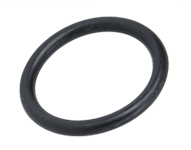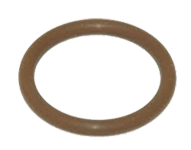O-ring Specs & Shelf Life
The O-ring specifications and shelf life for the most common O-ring materials are provided below.
Zero-Leak Gold standard plugs are supplied with the O-ring installed. EPCO can provide any O-ring material that is commercially available, including Buna, Viton, EPDM, Fluorosilicone and AFLAS.
Why are ZLG plug O-rings 70d and SAE 90d? What about the O-ring size relationships—ZLG vs. SAE?
Typical ORB plugs use a hard 90d O-ring because the O-ring acts very much like a gasket. During the installation of the plug the O-ring is forced into the taper of the port in an attempt to create the only seal. The cross sectional area of the O-ring is larger than the cross sectional area in which it is installed. During installation the O-ring maybe forced into the threads of port and plug where it can become nibbled. The O-ring may also be extruded from the spot faced area of the port where it can be damaged resulting in a leak path.
The Zero-Leak Gold Plug uses a softer 70d O-ring so the O-ring can respond to the system pressure if the primary seal is compromised. The Zero-Leak Gold O-ring is smaller in cross sectional area than the cross sectional area in which it rests. Under pressure the O-ring acts as a semi-viscous fluid and moves into the leak path to create the second seal. The Zero-Leak Gold Plug O-ring is smaller than its SAE J514 counterpart. All Zero-Leak Gold O-rings are standard metric size O-rings. The O-ring sizes for each ZLGP are listed in the plug/spec sheets next to the corresponding ZLG Plug size.
Standard O-ring Options

| Basic Requirements | Specification | 1255 |
| Hardness, points | 70+5 | 71 |
| Tensile strength, min, psi | 2031 | 2175 |
| Ultimate elongation, min, % | 250 | 258 |
| Tear resistance, Kg-cm | – | 46 |
| Modulus at 100%, psi | – | 700 |
| Modulus at 200%, psi | – | 1784 |
| Specific gravity | – | 1.22 |
| Additional Requirements | Specification | 1255 |
| A14 Heat resistance, Test Method D573, 70h at 100C | ||
| Change in hardness, points | – | +2 |
| Change in tensile strength, % | – | +4 |
| Change in ultimate elongation, % | – | -14 |
| Change in volume, % | – | -1.2 |
| B14 Compression set, Test Methods D395, Method B, max,%, 22h at 100C | 25 | 8 |
| EA14 Water resistance, Test Method D471, 70h at 100C | ||
| Change in hardness, points | ±10 | -3 |
| Change in tensile strength, % | – | +1 |
| Change in ultimate elongation, % | – | -6 |
| Change in volume, % | ±15 | +5.4 |
| EF11 Fluid resistance, Test Method D471, Reference Fuel A, 70h at 23C | ||
| Change in hardness, points | ±10 | -3 |
| Change in tensile strength, max, % | -25 | -6 |
| Change in ultimate elongation, max, % | -25 | -4 |
| Change in volume, % | -5 to +10 | +2.5 |
| EF21 Fluid resistance, Test Method D471 | ||
| Change in hardness, points | 0 to -30 | -14 |
| Change in tensile strength, max, % | -60 | -42 |
| Change in ultimate elongation, max, % | -60 | -38 |
| Change in volume, % | 0 to +40 | +23.8 |
| EO14 Fluid resistance, Test Method D471, No. 1 Oil, 70h at 100C | ||
| Change in hardness, points | -5 to +10 | +7 |
| Change in tensile strength, max, % | -25 | +10 |
| Change in ultimate elongation, max, % | -45 | -12 |
| Change in volume, % | -10 to +5 | -9.5 |
| EO34 Fluid resistance, Test Method D471, No. 3 Oil, 70h at 100C | ||
| Change in hardness, points | -10 to +5 | -2 |
| Change in tensile strength, max, % | -45 | +6 |
| Change in ultimate elongation, max, % | -45 | -4 |
| Change in volume, % | 0 to +25 | +0.8 |
| F17 Low-temperature brittleness, Test Methods D2137, Method A, 9.3.2, nonbrittle after 3 min at -40C | pass | pass |
| TR10 Retraction at Lower Temperatures (TR Test), ASTM D1329 – 08, Celcius | -29C | |

75 Durometer Brown Viton
To meet ASTM D 2000
M2HK710A1-10B38C12EF31EO78Z1Z2
| Basic Requirements | Specification | 2988 |
| Z1 Hardness, points | 75 + 5 | 76 |
| Tensile strength, min, psi | 1450 | 1802 |
| Ultimate elongation, min, % | 175 | 193 |
| Tear resistance, Kg-cm | – | 24 |
| Modulus at 100%, psi | – | 1133 |
| Specific gravity | – | 2.168 |
| Additional Requirements | Specification | 2988 |
| A1-10 Heat resistance, test method D573, 70h at 250C | ||
| Change in hardness, max, points | + 10 | + 4 |
| Change in tensile strength, max, % | – 25 | – 4 |
| Change in ultimate elongation, max, % | – 25 | – 20 |
| Change in volume, % | – | – 3 |
| B38 Compression set, Test Methods D395, Method B, 22h at 200C, max, % | 50 | 20 |
| C12 Resistance to ozone, 50 pphm x 70h at 40C | Pass | Pass |
| EF31 Fluid resistance, Test Method D471, Reference Fuel C, 70h at 23C | ||
| Change in hardness, points | ± 5 | – 4 |
| Change in tensile strength, max, % | – 25 | – 8 |
| Change in ultimate elongation, max, % | – 20 | – 17 |
| Change in volume, % | 0 to + 10 | + 5 |
| EO78 Fluid resistance, Test Method D471, Service Fluid No. 101, 70h at 200C | ||
| Change in hardness, points | – 15 to + 5 | -9 |
| Change in tensile strength, max, % | – 40 | – 22 |
| Change in ultimate elongation, max, % | – 20 | – 18 |
| Change in volume, % | 0 to + 5 | + 13 |
| EO14 Fluid resistance, Test Method D471, ASTM #7700 Oil, 70h at 200C | ||
| Change in hardness, points | – | – 12 |
| Change in tensile strength, % | – | – 23 |
| Change in ultimate elongation, % | – | – 29 |
| Change in volume, % | – | + 17 |
| Z2 TR10 Low Temperature Retraction, Test Method D1329, 38.1mm die, 50% elongation, retraction 10% min, Value C degrees | – 16.3 (2.66F) | |
O-ring ‘shelf-life’ is the estimated period from the date of cure to the date installed that O-rings will retain physical properties conforming to the specifications. The shelf lives shown below assume normal storage conditions, with minimal exposure to sunlight, ozone, chemicals and extremes of temperature.

O-ring ‘shelf-life’ is the estimated period from the date of cure to the date installed that O-rings will retain physical properties conforming to the specifications. The shelf lives shown below assume normal storage conditions, with minimal exposure to sunlight, ozone, chemicals and extremes of temperature.
| Polymer Name | Chemical Name | Shelf Life (years) |
| Aflas | Fluorocarbon Propylene | 20 |
| Butyl Rubber | Isoprene/Isobutylene | 10 |
| Carboxy Nitrile | Carboxylated Nitrile | 10 |
| EPDM | Ethylene/Propylene/Dienne | 10 |
| Fluorosilicone | Fluorinated Polysiloxane | 20 |
| Hydrin | Epichlorohydrin | 10 |
| Hypalon | Chlorosulfonated Polyethylene | 10 |
| Natural Rubber | Natural, Hevea | 3 |
| Neoprene | Polychloroprene | 10 |
| Nitrile | Butadienne/Acrylonitrile | 10 |
| Saturated Nitrile | HSN | 10 |
| Silicone | Polysiloxane | 20 |
| Thiokol | Polysulfide | 20 |
| Urethane (ester) | Polyurethane | 5 |
| Urethane (ether) | Polyurethane | 10 |
| Vamac | Polyetheracrylate | 20 |
| Viton / Fluorel | Fluorocarbon | 20 |
Contact us with any inquiries about specific O-ring materials for your Zero-Leak Gold Plug applications.
